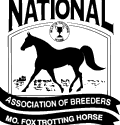About the Missouri Foxtrotting Horse
The foxtrot is a broken diagonal gait performed by walking in front and trotting behind, with reach in each stride. The front hoof of the diagonal pair strikes the ground just before the rear hoof, and one front hoof is on the ground at all times in a correct fox trot.
Section 1. Conformation
The Missouri Fox Trotting Horse generally stands between 14 and 16 hands in height, and averages between 900 to 1200 pounds. The horse should stand well on its feet, be erect, wide awake and alert. The neck should be graceful, in proportion to length of body, and joined to the body in a manner pleasing to the eye. The fox trotting horse should have a neat, clean, symmetrically shaped head of medium length; pointed ears that are well shaped; eyes that are large, wide set and bright; and a tapered muzzle with large nostrils. The back should be reasonable short and strong, the body deep and the ribs well-sprung. The flank should be sleek, and the chest deep and well ribbed. The shoulders should be sloped at a 45 to 50 degree angle, and moderately muscled. The legs should be muscular and tapered. The foot should be well made, strong and in proper proportion to the size of the horse. The overall condition of the horse should be reflected by its demeanor, body weight, muscular definition and tone, hair coat, and the feet. In form to function, good conformation permits the gaits to be performed in the proper manner. Proper conditioning and correct conformation will permit the horse to carry weight for an extended period of time, in comfort to the rider.
Section 2. Fox Trot
The fox trot has a motion and rhythm that carries from the nose through the tail. The fox trot gait will be performed in a stylish collected manner by walking in front and trotting behind with striding reach, both front and rear. There should not be excessive animation, nor should there be climbing or exaggerated knee motion in the front legs. The back feet will exhibit a sliding action resulting from the horse breaking at the hocks. The horse will disfigure or overstep his track, and shall travel straight on all four legs. The head will be carried slightly elevated, with rhythmic motion in time with the movement of the rear feet. The tail will be carried naturally, and should emphasize the rhythm of the gait. The exceptional rhythm of the fox trotting horse begins at the tip of the nose with the characteristic headshake and continues back through the ripple of the tail.
Section 3. Flat Foot Walk
The flat foot walk shall be a flat, four beat gait performed in a square, stylish manner. The gait is to be accomplished with animation, overstriding the front track. There is to be reach in each stride, front and rear. A four beat gait is distinctly different from the fox trot which has a broken rhythm. When correctly performing the flat foot walk, you will hear a steady, equal four beat cadence produced by the hooves, the head shake will be more animated than in the fox trot, and the rider will be getting a smooth ride.
Section 4. Canter
The canter is a three beat gait and shall be performed in a straight, collected manner with the head and tail slightly elevated. The horse shall travel with a forward rolling motion while on the correct lead, both front and rear. The three-beat gait is performed with a rocking motion, starting from the outside rear foot, then to the inside rear-outside front combination, and then to the inside front foot. The head should be at its lowest point when the inside front foot is on the ground. The canter is not a fast moving gait, and the horse should appear relaxed and move freely.
Section 5. Overview
The exhibition of the horse in the show ring should present the Missouri Fox Trotting Horse performing the gaits in the proper manner. While a degree of latitude may be given in the show arena, the correctness of the gaits and the equitation and comfort of the rider is necessary to showcase our great horse to its best advantage.
——–
Standards of the Fox Trotting Horse
Standards as excerpted from the “Official Handbook: Rules, Standards & Policies of the MFTHBA, effective date August 1, 2009, pages 21-22”
